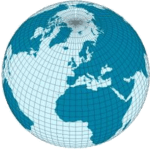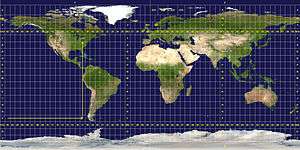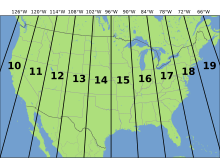Universal Transverse Mercator coordinate system
| Geodesy | ||||||||||||||||
|---|---|---|---|---|---|---|---|---|---|---|---|---|---|---|---|---|
 | ||||||||||||||||
| Fundamentals | ||||||||||||||||
| Concepts | ||||||||||||||||
| Technologies | ||||||||||||||||
| Standards | ||||||||||||||||
|
||||||||||||||||
| History | ||||||||||||||||
The Universal Transverse Mercator (UTM) conformal projection uses a 2-dimensional Cartesian coordinate system to give locations on the surface of the Earth. Like the traditional method of latitude and longitude, it is a horizontal position representation, i.e. it is used to identify locations on the Earth independently of vertical position. However, it differs from that method in several respects.
The UTM system is not a single map projection. The system instead divides the Earth into sixty zones, each being a six-degree band of longitude, and uses a secant transverse Mercator projection in each zone.

History
Most American published sources do not indicate an origin for the UTM system. The NOAA website states the system to have been developed by the United States Army Corps of Engineers,[1] and published material that does state an origin apparently based on that account. However, a series of aerial photos found in the Bundesarchiv-Militärarchiv (the military section of the German Federal Archives) apparently dating from 1943–1944 bear the inscription UTMREF followed by grid letters and digits, and projected according to the transverse Mercator,[2] a finding that would indicate that something called the UTM Reference system was developed in the 1942–43 time frame by the Wehrmacht. It was probably carried out by the Abteilung für Luftbildwesen (Department for Aerial Photography). From 1947 onward the US Army employed a very similar system, but with the now-standard 0.9996 scale factor at the central meridian as opposed to the German 1.0.[2] For areas within the contiguous United States the Clarke Ellipsoid of 1866[3] was used. For the remaining areas of Earth, including Hawaii, the International Ellipsoid[4] was used. The WGS84 ellipsoid is now generally used to model the Earth in the UTM coordinate system, which means current UTM northing at a given point can differ up to 200 meters from the old. For different geographic regions, other datum systems (e.g.: ED50, NAD83) can be used.
Prior to the development of the Universal Transverse Mercator coordinate system, several European nations demonstrated the utility of grid-based conformal maps by mapping their territory during the interwar period. Calculating the distance between two points on these maps could be performed more easily in the field (using the Pythagorean theorem) than was possible using the trigonometric formulas required under the graticule-based system of latitude and longitude. In the post-war years, these concepts were extended into the Universal Transverse Mercator/Universal Polar Stereographic (UTM/UPS) coordinate system, which is a global (or universal) system of grid-based maps.
The transverse Mercator projection is a variant of the Mercator projection, which was originally developed by the Flemish geographer and cartographer Gerardus Mercator, in 1570. This projection is conformal, which means it preserves angles and therefore shapes across small regions. However, it distorts distance and area.
Definitions
UTM zone

The UTM system divides the Earth between 80°S and 84°N latitude into 60 zones, each 6° of longitude in width. Zone 1 covers longitude 180° to 174° W; zone numbering increases eastward to zone 60, which covers longitude 174° to 180° E.
Each of the 60 zones uses a transverse Mercator projection that can map a region of large north-south extent with low distortion. By using narrow zones of 6° of longitude (up to 800 km) in width, and reducing the scale factor along the central meridian to 0.9996 (a reduction of 1:2500), the amount of distortion is held below 1 part in 1,000 inside each zone. Distortion of scale increases to 1.0010 at the zone boundaries along the equator.
In each zone the scale factor of the central meridian reduces the diameter of the transverse cylinder to produce a secant projection with two standard lines, or lines of true scale, about 180 km on each side of, and about parallel to, the central meridian (Arc cos 0.9996 = 1.62° at the Equator). The scale is less than 1 inside the standard lines and greater than 1 outside them, but the overall distortion is minimized.
Overlapping grids
Distortion of scale increases in each UTM zone as the boundaries between the UTM zones are approached. However, it is often convenient or necessary to measure a series of locations on a single grid when some are located in two adjacent zones. Around the boundaries of large scale maps (1:100,000 or larger) coordinates for both adjoining UTM zones are usually printed within a minimum distance of 40 km on either side of a zone boundary. Ideally, the coordinates of each position should be measured on the grid for the zone in which they are located, but because the scale factor is still relatively small near zone boundaries, it is possible to overlap measurements into an adjoining zone for some distance when necessary.
Latitude bands
Latitude bands are not a part of UTM, but rather a part of the military grid reference system (MGRS).[5] They are however sometimes used.
Latitude bands
Each zone is segmented into 20 latitude bands. Each latitude band is 8 degrees high, and is lettered starting from "C" at 80°S, increasing up the English alphabet until "X", omitting the letters "I" and "O" (because of their similarity to the numerals one and zero). The last latitude band, "X", is extended an extra 4 degrees, so it ends at 84°N latitude, thus covering the northernmost land on Earth.
Latitude bands "A" and "B" do exist, as do bands "Y" and "Z". They cover the western and eastern sides of the Antarctic and Arctic regions respectively. A convenient mnemonic to remember is that the letter "N" is the first letter in "northern hemisphere", so any letter coming before "N" in the alphabet is in the southern hemisphere, and any letter "N" or after is in the northern hemisphere.
Notation
The combination of a zone and a latitude band defines a grid zone. The zone is always written first, followed by the latitude band. For example (see image, top right), a position in Toronto, Canada, would find itself in zone 17 and latitude band "T", thus the full grid zone reference is "17T". The grid zones serve to delineate irregular UTM zone boundaries. They also are an integral part of the military grid reference system.
A note of caution: A method also is used that simply adds N or S following the zone number to indicate North or South hemisphere (the easting and northing coordinates along with the zone number supplying everything necessary to geolocate a position except which hemisphere). However, this method has caused some confusion since, for instance, "50S" can mean southern hemisphere but also grid zone "50S" in the northern hemisphere.[6] There are many possible ways to disambiguate between the two methods, two of which are demonstrated later in this article.
Exceptions
These grid zones are uniform over the globe, except in two areas. On the southwest coast of Norway, grid zone 32V (9° of longitude in width) is extended further west, and grid zone 31V (3° of longitude in width) is correspondingly shrunk to cover only open water. Also, in the region around Svalbard, the four grid zones 31X (9° of longitude in width), 33X (12° of longitude in width), 35X (12° of longitude in width), and 37X (9° of longitude in width) are extended to cover what would otherwise have been covered by the seven grid zones 31X to 37X. The three grid zones 32X, 34X and 36X are not used.
 Europe
Europe Africa
Africa South America
South America Bering Sea with Alaska
Bering Sea with Alaska
Picture gallery: Grid zones in various parts of the world
Locating a position using UTM coordinates
A position on the Earth is given by the UTM zone number and the easting and northing planar coordinate pair in that zone. The point of origin of each UTM zone is the intersection of the equator and the zone's central meridian. To avoid dealing with negative numbers, the central meridian of each zone is defined to coincide with 500000 meters East. In any zone a point that has an easting of 400000 meters is about 100 km west of the central meridian. For most such points, the true distance would be slightly more than 100 km as measured on the surface of the Earth due to the distortion of the projection. UTM eastings range from about 167000 meters to 833000 meters at the equator.
In the northern hemisphere positions are measured northward from zero at the equator. The maximum "northing" value is about 9300000 meters at latitude 84 degrees North, the north end of the UTM zones. In the southern hemisphere northings decrease southward from the equator to about 1100000 meters at 80 degrees South, the south end of the UTM zones. The northing at the equator is set at 10000000 meters so no point has a negative northing value.
The CN Tower is at 43°38′33.24″N 79°23′13.7″W / 43.6425667°N 79.387139°W, which is in UTM zone 17, and the grid position is 630084 m east, 4833438 m north. Two points in Zone 17 have these coordinates, one in the northern hemisphere and one in the south; one of two conventions is used to say which:
- Append a hemisphere designator to the zone number, "N" or "S", thus "17N 630084 4833438". This supplies the minimum information to define the position uniquely.
- Supply the grid zone, i.e., the latitude band designator appended to the zone number, thus "17T 630084 4833438". The provision of the latitude band along with northing supplies redundant information (which may, as a consequence, be contradictory if misused).
Because latitude band "S" is in the northern hemisphere, a designation such as "38S" is unclear. The "S" might refer to the latitude band (32°N–40°N) or it might mean "South". It is therefore important to specify which convention is being used, e.g., by spelling out the hemisphere, "North" or "South", or using different symbols, such as − for south and + for north.
Simplified formulas
These formulas are truncated version of Transverse Mercator: flattening series, which were originally derived by Johann Heinrich Louis Krüger in 1912.[7] They are accurate to around a millimeter within 3,000 km of the central meridian.[8] Concise commentaries for their derivation have also been given.[9][10]
The WGS 84 spatial reference system describes Earth as an oblate spheroid along north-south axis with an equatorial radius of km and an inverse flattening of . Let's take a point of latitude and of longitude and compute its UTM coordinates as well as point scale factor and meridian convergence using a reference meridian of longitude . By convention, in the northern hemisphere km and in the southern hemisphere km. By convention also and km.
In the following formulas, the distances are in kilometers. In advance let's compute some preliminary values:
From latitude, longitude (φ, λ) to UTM coordinates (E, N)
First let's compute some intermediate values:
The final formulas are:
From UTM coordinates (E, N, Zone, Hemi) to latitude, longitude (φ, λ)
Note: Hemi=+1 for Northern, Hemi=-1 for Southern
First let's compute some intermediate values:
The final formulas are:
See also
- Military grid reference system, a variant of UTM designed to simplify transfer of coordinates.
- Transverse Mercator projection, the map projection used by UTM.
- Universal Polar Stereographic coordinate system, used at the North and South poles.
References
- ↑ http://www.history.noaa.gov/stories_tales/geod1.html
- 1 2 BUCHROITHNER, Manfred F.; PFAHLBUSCH, René. Geodetic grids in authoritative maps–new findings about the origin of the UTM Grid. Cartography and Geographic Information Science, 2016
- ↑ Equatorial radius 6,378,206.4 meters, polar radius 6,356,583.8 meters
- ↑ Equatorial radius 6,378,388 meters, reciprocal of the flattening 297 exactly
- ↑ "Military Map Reading 201" (PDF). National Geospatial-Intelligence Agency. 2002-05-29. Retrieved 2009-06-19.
- ↑ See "The Letter after the UTM Zone Number: Is that a Hemisphere or a Latitudinal Band?", page 7,
- ↑ Krüger, L. (1912). Konforme Abbildung des Erdellipsoids in der Ebene. Royal Prussian Geodetic Institute, New Series 52.
- ↑ Karney, Charles F. F. (2011). "Transverse Mercator with an accuracy of a few nanometers". J. Geodesy. 85 (8): 475–485. arXiv:1002.1417
 . doi:10.1007/s00190-011-0445-3.
. doi:10.1007/s00190-011-0445-3. - ↑ Kawase, K. (2012): Concise Derivation of Extensive Coordinate Conversion Formulae in the Gauss-Krüger Projection, Bulletin of the Geospatial Information Authority of Japan, 60, pp 1–6
- ↑ Kawase, K. (2011): A General Formula for Calculating Meridian Arc Length and its Application to Coordinate Conversion in the Gauss-Krüger Projection, Bulletin of the Geospatial Information Authority of Japan, 59, 1–13
Further reading
- Snyder, John P. (1987). Map Projections – A Working Manual. U.S. Geological Survey Professional Paper 1395. United States Government Printing Office, Washington, D.C.
External links
- Online Universal Transverse Mercator to Geographic coordinates converter
- Transverse Mercator in proj4